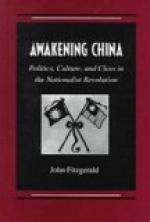Entering the Pearl River, a fine stream 500 miles in length, whose affluents spread like a fan over two provinces, we come to the viceregal capital, as Canton deserves to be called, though the viceroy actually resides in another city. The river is alive with steamboats, large and small, mostly under the British flag; but native craft of the old style have not yet been put to flight. Propelled by sail or oar, the latter creep along the shore; and at Pagoda Anchorage near the city they form a floating town in which families are born and die without ever having a home on terra firma.
Big-footed women are seen earning an honest living by plying the oar, or swinging on the scull-beam with babies strapped on their backs. One may notice also the so-called “flower-boats,” embellished like the palaces of water fairies. Moored in one locality, they are a well-known resort of the vicious. In the fields are [Page 10] the tillers of the soil wading barefoot and bareheaded in mud and water, holding plough or harrow drawn by an amphibious creature called a carabao or water-buffalo, burying by hand in the mire the roots of young rice plants, or applying as a fertiliser the ordure and garbage of the city. Such unpoetic toils never could have inspired the georgic muse of Vergil or Thomson.
The most picturesque structure that strikes the eye as one approaches the city is a Christian college—showing how times have changed. In 1850 the foreign quarter was in a suburb near one of the gates. There I dined with Sir John Bowring at the British Consulate, having a letter of introduction from his American cousin, Miss Maylin, a gifted lady of Philadelphia. There, too, I lodged with Dr. Happer, who by the tireless exertions of many years succeeded in laying the foundations of that same Christian college. For him it is a monument more lasting than brass; for China it is only one of many lighthouses now rising at commanding points on the seacoast and in the interior.
In passing the Fati, a recreation-ground near the city, a view is obtained of the amusements of the rich and the profligate. We see a multitude seated around a cockpit intent on a cock-fight; but the cocks are quails, not barnyard fowls. Here, too, is a smaller and more exclusive circle stooping over a pair of crickets engaged in deadly combat. Insects of other sorts or pugnacious birds are sometimes substituted; and it might be supposed that the people must be warlike in their disposition, to enjoy such spectacles. The fact is, they are fond of fighting by proxy. What attracts them [Page 11] most, however, is the chance of winning or losing a wager.
A more intellectual entertainment to be seen in many places is the solving of historical enigmas. Some ancient celebrity is represented by an animal in a rhyming couplet; and the man who detects the hero under this disguise wins a considerable sum. Such is the native passion for gambling that bets are even made on the result of the metropolitan examinations, particularly on the province to which will fall the honour of the first prize, that of the scholar-laureateship.




